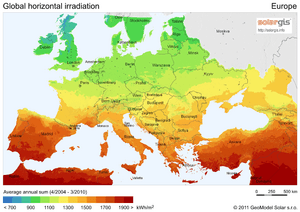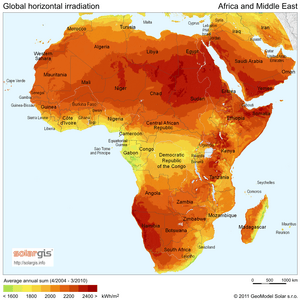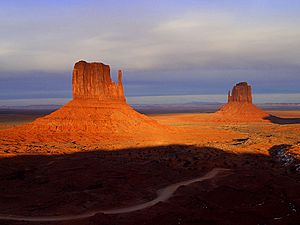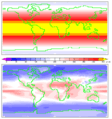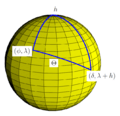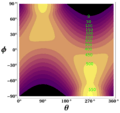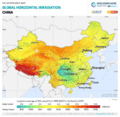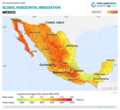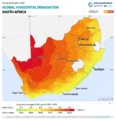Insolation facts for kids
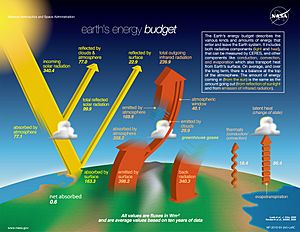
Insolation is a fancy word for "incoming solar radiation." It's all about the sunlight that reaches our planet. First, it hits Earth's atmosphere, and then it reaches the ground.
This sunlight brings heat and energy. We measure insolation by how much solar energy arrives per square centimeter each minute. Simply put, insolation is the amount of sunlight energy the Earth receives.
The amount of insolation changes based on many things. These include the time of year (season), how far north or south you are (latitude), how clear the sky is, and even the slope of the ground.
Insolation directly affects temperature. More insolation means higher temperatures. On any given day, the strongest sunlight and thus the most insolation is usually received around noon.
Contents
What Affects How Much Sunlight We Get?
The amount of sunlight (insolation) that reaches Earth's surface isn't the same everywhere. It changes depending on the place and the time. For example, areas near the equator get the most sunlight all year. As you move closer to the North or South Poles, the amount of sunlight gradually decreases. We also get more sunlight in summer and less in winter.
The main things that change how much insolation we receive are:
- The solar constant
- The angle of the sun's rays
- How long the day lasts
- Earth's distance from the Sun
- How clear the atmosphere is
The Solar Constant
The "solar constant" is the average amount of sunlight energy that hits the very top of Earth's atmosphere. Imagine a flat surface facing the sun directly. This constant amount is about 1368 watts per square meter.
This "constant" actually changes a tiny bit. This is because of things like sunspots. Sunspots are darker, cooler areas on the Sun's surface. Scientists have found that when there are more sunspots, the Sun releases a bit more energy. The number of sunspots goes up and down in a regular cycle, usually every 11 years.
The Angle of the Sun's Rays
Earth is shaped like a sphere (a ball). Because of this, the sun's rays hit different parts of the surface at different angles. This angle depends on your latitude, or how far north or south you are from the equator.
The closer you are to the poles, the more slanted the sun's rays are. When rays hit straight on, they cover a smaller area, making the energy more concentrated. Slanted rays spread their energy over a larger area, so each part of that area gets less energy. Also, slanted rays have to travel through more of Earth's atmosphere, which can block some of their energy.
How Long the Day Lasts
The length of the day, or how many hours of sunlight a place gets, greatly affects insolation. The longer the sun shines, the more solar energy that part of Earth will receive.
For example, at the equator, days and nights are always about 12 hours long. But near the Arctic and Antarctic, the amount of daylight can vary from zero hours (total darkness) to 24 hours (constant daylight).
During the autumn and spring equinoxes (around September 23 and March 21), the sun is directly overhead at the equator at noon. On these days, day and night are equal all over the world. The equator gets the most insolation, and it decreases as you move towards the poles. This is because the sun's rays are vertical at the equator but become more slanted towards the poles.
Earth's Distance from the Sun
Earth travels around the Sun in an oval-shaped path, not a perfect circle. This means the distance between Earth and the Sun changes throughout the year. This changing distance causes some of our seasonal differences in sunlight.
The average distance between Earth and the Sun is about 149.6 million kilometers (92.9 million miles).
- When Earth is farthest from the Sun, it's called aphelion. This happens around July 4, when we are about 152 million km away.
- When Earth is closest to the Sun, it's called perihelion. This happens around January 3, when we are about 147 million km away.
During aphelion (when Earth is farthest), the Northern Hemisphere is tilted towards the sun. It receives about 7 percent less energy than the Southern Hemisphere does during perihelion (when Earth is closest).
How Clear the Atmosphere Is
Earth's atmosphere isn't perfectly clear for all sunlight coming from the Sun. It's made of different gases, water vapor, and tiny particles. These things can block, scatter, or absorb some of the incoming sunlight before it reaches the ground.
The atmosphere contains gases like nitrogen, oxygen, carbon dioxide, and ozone. It also has water vapor, which is water in a gas form. All these parts of the atmosphere play a role in how much sunlight actually reaches Earth's surface.
The longer the daylight lasts, the more insolation a place receives each day.
Images for kids
-
The shield effect of Earth's atmosphere on solar irradiation. The top image is the annual mean solar irradiation (or insolation) at the top of Earth's atmosphere (TOA); the bottom image shows the annual insolation reaching the Earth's surface after passing through the atmosphere. Note that the two images use the same color scale.
-
\overline{Q}^\text{day}, the theoretical daily-average irradiation at the top of the atmosphere, where θ is the polar angle of the Earth's orbit, and θ = 0 at the vernal equinox, and θ = 90° at the summer solstice; φ is the latitude of the Earth. The calculation assumed conditions appropriate for 2000 A.D.: a solar constant of S0 = 1367 W m−2, obliquity of ε = 23.4398°, longitude of perihelion of ϖ = 282.895°, eccentricity e = 0.016704. Contour labels (green) are in units of W m−2.
-
Projection effect: One sunbeam one mile wide shines on the ground at a 90° angle, and another at a 30° angle. The oblique sunbeam distributes its light energy over twice as much area.
-
Sunlight carries radiant energy in the wavelengths of visible light. Radiant energy may be developed for solar power generation.
See also
 In Spanish: Irradiación solar para niños
In Spanish: Irradiación solar para niños


